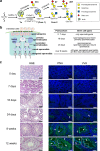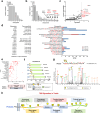Global characterization of mouse testis O-glycoproteome landscape during spermatogenesis
- PMID: 40102425
- PMCID: PMC11920050
- DOI: 10.1038/s41467-025-57980-7
Global characterization of mouse testis O-glycoproteome landscape during spermatogenesis
Abstract
Protein O-glycosylation plays critical roles in sperm formation and maturation. However, detailed knowledge on the mechanisms involved is limited due to lacking characterization of O-glycoproteome of testicular germ cells. Here, we performed a systematic analysis of site-specific O-glycosylation in mouse testis, and established an O-glycoproteome map with 349 O-glycoproteins and 799 unambiguous O-glycosites. Moreover, we comprehensively investigated the distribution properties of O-glycosylation in testis and identified a region near the N-terminal of peptidase S1 domain that is susceptible to O-glycosylation. Interestingly, we found dynamic changes with an increase Tn and a decrease T structure from early to mature developmental stages. Notably, the importance of O-glycosylation was supported by its effects on the stability, cleavage, and interaction of acrosomal proteins. Collectively, these data illustrate the global properties of O-glycosylation in testis, providing insights and resources for future functional studies targeting O-glycosylation dysregulation in male infertility.
© 2025. The Author(s).
Conflict of interest statement
Competing interests: The authors declare no competing interests.
Figures







Similar articles
-
Systematic characterization of human testis-specific actin capping protein β3 as a possible biomarker for male infertility.Hum Reprod. 2017 Mar 1;32(3):514-522. doi: 10.1093/humrep/dew353. Hum Reprod. 2017. PMID: 28104696
-
Spatial Organization of the Sperm Cell Glycoproteome.Mol Cell Proteomics. 2025 Jan;24(1):100893. doi: 10.1016/j.mcpro.2024.100893. Epub 2024 Dec 12. Mol Cell Proteomics. 2025. PMID: 39674511 Free PMC article.
-
Precision Glycoproteomics Reveals Distinctive N-Glycosylation in Human Spermatozoa.Mol Cell Proteomics. 2022 Apr;21(4):100214. doi: 10.1016/j.mcpro.2022.100214. Epub 2022 Feb 18. Mol Cell Proteomics. 2022. PMID: 35183770 Free PMC article.
-
Organization and modifications of sperm acrosomal molecules during spermatogenesis and epididymal maturation.Microsc Res Tech. 2003 May 1;61(1):39-45. doi: 10.1002/jemt.10315. Microsc Res Tech. 2003. PMID: 12672121 Review.
-
Biological Functions and Large-Scale Profiling of Protein Glycosylation in Human Semen.J Proteome Res. 2020 Oct 2;19(10):3877-3889. doi: 10.1021/acs.jproteome.9b00795. Epub 2020 Sep 24. J Proteome Res. 2020. PMID: 32875803 Review.
References
-
- Eisenberg, M. L. et al. Male infertility. Nat. Rev. Dis. Prim.9, 49 (2023). - PubMed
-
- Tatum, M. China’s fertility treatment boom. Lancet396, 1622–1623 (2020). - PubMed
-
- Agarwal, A. et al. Male infertility. Lancet397, 319–333 (2021). - PubMed
-
- Auger, J. Spermatogenic Cells—Structure. Encycl. Reprod.1, 53–60 (2018).
MeSH terms
Substances
Grants and funding
LinkOut - more resources
Full Text Sources

